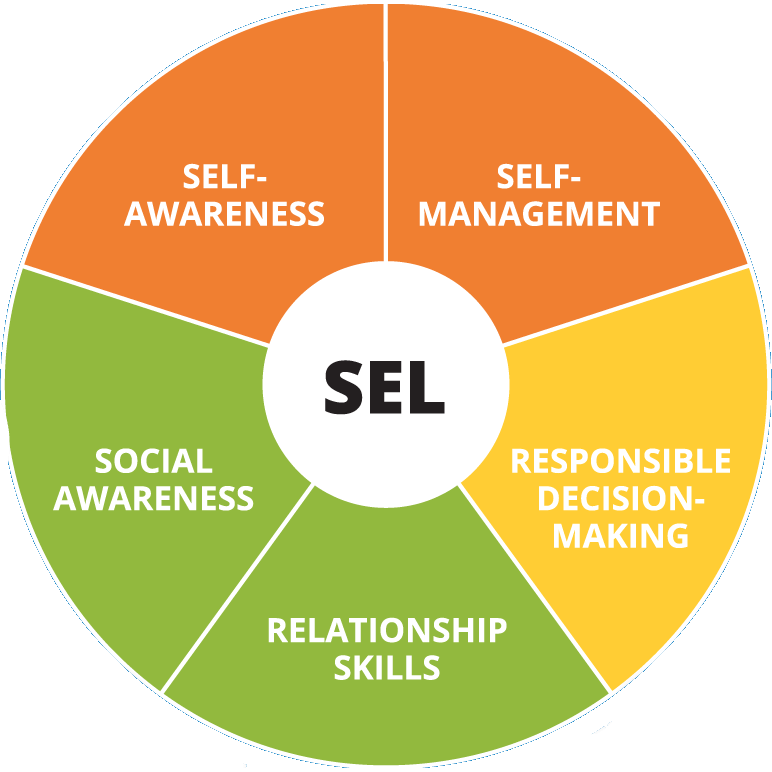BPS District Social Emotional Learning Book
| Site: | Learnbps |
| Class: | BPS-Social Emotional Learning |
| Book: | BPS District Social Emotional Learning Book |
| Printed by: | Guest user |
| Date: | Monday, December 29, 2025, 3:51 AM |
SEL-Introduction
 What are the SEL Competencies?
What are the SEL Competencies?
Social and emotional learning (SEL) is the process through which you acquire and effectively apply the knowledge, attitudes, and skills necessary to understand and manage emotions, set and achieve positive goals, feel and show empathy for others, establish and maintain positive relationships, and make responsible decisions.
K-2 Learning Goals
Elementary Grades K-2
(K-2) K2 Indicators
Learning Goals
SEL-K2.SeA Self-Awareness
- SEL-K2.SeA.1ie Recognize and accurately label emotions, and identify situations that cause those emotions.
- SEL-K2.SeA.2rs Differentiate between likes and dislikes.
- SEL-K2.SeA.3sce Accept failure and demonstrate the ability to recover from perceived failures.
- SEL-K2.SeA.4asp Identify and seek help when appropriate.
SEL-K2.SeM Self-Management
- SEL-K2.SeM.1ic Demonstrate self-control in a variety of settings.
- SEL-K2.SeM.2sm Define stress.
- SEL-K2.SeM.3sd Identify what it means to be responsible and list personal responsibilities.
- SEL-K2.SeM.4s-m Utilize self-talk for the purpose of self-motivation.
- SEL-K2.SeM.5gs Identify goals for academic success and classroom behavior.
- SEL-K2.SeM.6os Utilize prescribed routines to understand physical and mental organizational strategies.
SEL-K2.SoA Social Awareness
- SEL-K2.SoA.1hs Identify a trusted adult for help when needed.
- SEL-K2.SoA.2ept Identify the feelings and perspectives of others.
- SEL-K2.SoA.3ad Recognize and acknowledge individual differences in others.
- SEL-K2.SoA.4rfo Describe positive qualities in others.
SEL-K2.ReS Relationship Skills
- SEL-K2.ReS.1c Demonstrate verbal etiquette to foster better communication.
- SEL-K2.ReS.2se Identify opportunities for social participation at home, school and in the community.
- SEL-K2.ReS.3rb Describe approaches for making and keeping friends.
- SEL-K2.ReS.4tw Demonstrate appropriate strategies for receiving feedback from others for self-improvement and to promote group effectiveness.
- SEL-K2.ReS.5cr Identify conflict in various situations.
SEL-K2.RDM Responsible Decision-Making
- SEL-K2.RDM.1ip Define a problem.
- SEL-K2.RDM.2as Analyze potential consequences of choices.
- SEL-K2.RDM.3sp Explain a problem solving process.
- SEL-K2.RDM.4e&r Explain the differences between safe and risky behaviors.
- SEL-K2.RDM.5er List age appropriate responsibilities at home and school.
3-5 Learning Goals
Elementary Grades 3-5
(3-5) EL Indicators
Learning Goals
SEL-35.SeA Self-Awareness
- SEL-35.SeA.1ie Describe a variety of emotions, and understandings how emotions are linked to behavior.
- SEL-35.SeA.2rs Describe interests to pursue and skills to develop.
- SEL-35.SeA.3sce Develop a growth mindset for rigorous situations.
- SEL-35.SeA.4asp Describe an activity or task in which help is needed to be successful.
SEL-35.SeM Self-Management
- SEL-35.SeM.1ic Apply self-monitoring strategies to regulate emotions.
- SEL-35.SeM.2sm Identify personal stressors.
- SEL-35.SeM.3sd Display consistent behaviors to meet personal responsibilities.
- SEL-35.SeM.4s-m Identify internal and/or external motivating factors in a variety of situations.
- SEL-35.SeM.5gs Apply a goal setting process to work toward goal achievement (e.g. SMART).
- SEL-35.SeM.6os Identify strategies for planning, prioritizing and managing time.
SEL-35.SoA Social Awareness
- SEL-35.SoA.1hs Demonstrate appropriate strategies to ask for help in a variety of situations.
- SEL-35.SoA.2ept Describe feelings and perspectives of others..
- SEL-35.SoA.3ad Differentiate between static and dynamic personal characteristics and accept static characteristics.
- SEL-35.SoA.4rfo Demonstrate strategies for working and playing effectively with others.
SEL-35.ReS Relationship Skills
- SEL-35.ReS.1c Demonstrate non-verbal etiquette to foster better communication (e.g. looking and learning, etc).
- SEL-35.ReS.2se Analyze social situations at home, school and in the community (e.g. family meal time, free play, extracurricular activities, cances, diverse peer groups, etc).
- SEL-35.ReS.3rb Recognize and respond to social cues in a manner that builds and maintains healthy relationships.
- SEL-35.ReS.4tw Demonstrate appropriate strategies for providing and receiving feedback to promote group effectiveness.
- SEL-35.ReS.5cr Differentiate between conflict and bullying.
SEL-35.RDM Responsible Decision-Making
- SEL-35.RDM.1ip Identify problems in a variety of situations.
- SEL-35.RDM.2as Utilize refusal skills.
- SEL-35.RDM.3sp Apply strategies to appropriately solve problems.
- SEL-35.RDM.4e&r Compare and contrast the potential outcomes of engaging in safe and risky behavior.
- SEL-35.RDM.5er Demonstrate personal responsibility for decisions.
MS Learning Goals
Middle School
(6-8) MS Indicators
Learning Goals
SEL-MS.SeA Self-Awareness
- SEL-MS.S-A.1ie Distinguish different levels of emotions and explain the physical reaction to various emotions (e.g. how bodies looks and feel).
- SEL-MS.S-A.2rs Identify personal strengths and the skills required to develop those strengths.
- SEL-MS.S-A.3sce Understand the relationship between effort, attitude and achievement.
- SEL-MS.S-A.4asp Distinguish between personal feelings and how one is expected to feel in a variety of situations.
SEL-MS.SeM Self-Management
- SEL-MS.S-M.1ic Explain possible outcomes of expressing emotions in a various way.
- SEL-MS.S-M.2sm Apply stress management strategies.
- SEL-MS.S-M.3sd Display endurance when facing adversity for the purpose of personal growth.
- SEL-MS.S-M.4s-m Display indicators of a growth mindset.
- SEL-MS.S-M.5gs Create and monitor personal and academic goals to meet identified needs.
- SEL-MS.S-M.6os Apply strategies for planning, prioritizing and managing time.
SEL-MS.SoA Social Awareness
- SEL-MS.SA.1hs Identify support at home, school and community.
- SEL-MS.SA.2ept Demonstrate the ability to anticipate feelings and perspectives of others in a variety of situations.
- SEL-MS.SA.3ad Analyze how people from diverse peer groups can learn from each other.
- SEL-MS.SA.4rfo Evaluate strategies for being respectful of others and opposing stereotyping and prejudice.
SEL-MS.ReS Relationship Skills
- SEL-MS.RS.1c Demonstrate proper etiquette when communicating electronically.
- SEL-MS.RS.2se Demonstrate appropriate responses to social situations at home, school and in the community (e.g. family meal time, free play, extracurriculars, dances, diverse peer groups, volunteering, etc.).
- SEL-MS.RS.3rb Explain an approach to limit setting. (e.g. Acknowledge Feelings, Communicate the limit, Target alternate).
- SEL-MS.RS.4tw Demonstrate cooperation and teamwork to promote group effectiveness.
- SEL-MS.RS.5cr Apply conflict resolution strategies in a variety of situations (e.g. interpersonal, intrapersonal, intragroup, intergroup).
SEL-MS.RDM Responsible Decision-Making
- SEL-MS.RDM.1ip Demonstrate the ability to acknowledge problems in a variety of situations.
- SEL-MS.RDM.2as Analyze factual information surrounding situation.
- SEL-MS.RDM.3sp Evaluate potential solutions to problems.
- SEL-MS.RDM.4e&r Recognize unsafe or high risk situations and utilize strategies to remove oneself.
- SEL-MS.RDM.5er Evaluate how external influences such as media, peers, and/or cultural norms influence personal behavior.
HS Learning Goals
High School
(9-12) HS Indicators
Learning Goals
SEL-HS.S-A Self-Awareness
- SEL-HS.S-A.1ie Create a plan for managing a variety of emotions.
- SEL-HS.S-A.2rs Analyze perceived limitations and create a plan leveraging strengths to address limitations.
- SEL-HS.S-A.3sce Demonstrate resilience and a positive attitude for school and life.
- SEL-HS.S-A.4asp Advocate for oneself by creating 'I'-message to present personal perspective.
SEL-HS.S-M Self-Management
- SEL-HS.S-M.1ic Apply strategies to mitigate personal response to different levels of emotions.
- SEL-HS.S-M.2sm Create a long term plan for stress management throughout the lifespan.
- SEL-HS.S-M.3sd Consistently apply strategies for working hard in challenging settings.
- SEL-HS.S-M.4s-m Apply strategies for developing and maintaining a growth mindset. S-M
- SEL-HS.S-M.5gs Create a plan for monitoring progress toward personal and academic short and long-term goal achievement.
- SEL-HS.S-M.6os Create a plan for planning, prioritizing and managing time independently to maximize efficiency.
SEL-HS.SA Social Awareness
- SEL-HS.SA.1hs Evaluate and utilize available resources at home, school and the community.
- SEL-HS.SA.2ept Analyze the effect of personal behavior with reference to the feelings and perspectives of others and adjust personal behavior accordingly.
- SEL-HS.SA.3ad Demonstrate strategies fore expressing understanding towards those who held different beliefs.
- SEL-HS.SA.4rfo Evluate how society and cultural norms, morals and values affect personal interactions.
SEL-HS.RS Relationship Skills
- SEL-HS.RS.1c Evaluate the verbal and nonverbal cues from others to create differentiated communication plans.
- SEL-HS.RS.2se Evaluate personal engagement in social situations at home, school and in the community and create a plan for personal growth.
- SEL-HS.RS.3rb Demonstrate a variety of strategies for collaborating with peers, adults and others in the community.
- SEL-HS.RS.4tw Apply appropriate limit setting strategies (e.g. Acknowledge Feelings, Communicate the limit, Target alternative).
- SEL-HS.RS.5cr Evaluate personal response to conflict and create a plan for personal growth in resolving conflict.
SEL-HS.RDM Responsible Decision-Making
- SEL-HS.RDM.1ip Demonstrate the ability to accurately anticipate problems in a variety of situations.
- SEL-HS.RDM.2as Differentiate between emotional response and factual information surrounding situations.
- SEL-HS.RDM.3sp Create a plan to apply the most appropriate solution to problems.
- SEL-HS.RDM.4e&r Analyze how current choices affect one's future.
- SEL-HS.RDM.5er Apply moral, personal, an ethical standards when making decisions.
SEL-Competencies
Social and emotional learning (SEL) enhances students’ capacity to integrate skills, attitudes, and behaviors to deal effectively and ethically with daily tasks and challenges. There are five core competencies that can be taught in many ways
across many settings. Many educators and researchers are also exploring how best to assess these competencies.
The ability to accurately recognize one's own emotions, thoughts, and values and how they influence behavior. Te ability to accurately assess one's strengths and limitations, with a well-grounded sense of confidence, optimism, and a "growth mindset."
Indicators- IE Identifying Emotions
- RS Recognizing Strengths
- SCE Self-Confidences & Efficacy
- ASP Accurate Self-Perception
The ability to successfully regulate one's emotions, thoughts, and behaviors in different situations effectively managing stress, controlling impulses, and motivating oneself. The ability to set and work toward personal and academic goals.
Indicators- IC Impluse Control
- SM Stress Management
- SD Self-Discipline
- S-M Self-Management
- GS Goal Setting
- OS Organizational Skills
The ability to take the perspective of and empahtize with others, including those from diverse backgrounds and cutures. The ability to understand social and ethical norms for behavior and to recognize family, school, and community resources and support.
Indicators- HS Help Seeking
- EPT Empathy & Perspective Taking
- AD Appreciating Diversity
- RFO Respect for Others
The ability to establish and maintain healthy and rewarding relationships with diverse individuals and groups. The ability to communicate clearly, listen well, cooperate with others, resist inappropriate social pressure, negotiate conflict constructively, and seek and offer help when needed.
Indicators- C Communication
- SE Social Engagement
- RB Relationship Building
- TW Teamwork
- CR Conflict Resolution
The ability to make constructive choices about the personal behavior and social interactions based on ethical standards, safety concerns, and social norms. The realistic evaluation of consequences of various actions, and a consideration of the wellbeing of oneself and others.
Indicators- IP Identifying Problems
- AS Analyzing Situations
- SP Solving Problems
- E&R Evaluating & Reflecting
- ER Ethical Responsibility
SeA
Narrative
The ability to accurately recognize one's own emotions, thoughts, and values and how they influence behavior. The ability to accurately assess one's strengths and limitations, with a well-grounded sense of confidence, optimism, and a "growth mindset."
Indicators
- IE Identifying Emotions
- RS Recognizing Strengths
- SCE Self-Confidences & Efficacy
- ASP Accurate Self-Perception
Grade Span
Students will be able to ...
- SEL-K2.S-A.1ie Recognize and accurately label emotions, and identify situations that cause those emotions.
- SEL-K2.S-A.2rs Differentiate between likes and dislikes.
- SEL-K2.S-A.3sce Accept failure and demonstrate the ability to recover from perceived failures.
- SEL-K2.S-A.4asp Identify and seek help when appropriate.
- SEL-EL.S-A.1ie Describe a variety of emotions, and understandings how emotions are linked to behavior.
- SEL-EL.S-A.2rs Describe interests to pursue and skills to develop.
- SEL-EL.S-A.3sce Develop a growth mindset for rigorous situations.
- SEL-EL.S-A.4asp Describe an activity or task in which help is needed to be successful.
- SEL-MS.S-A.1ie Distinguish different levels of emotions and explain the physical reaction to various emotions (e.g. how bodies looks and feel).
- SEL-MS.S-A.2rs Identify personal strengths and the skills required to develop those strengths.
- SEL-MS.S-A.3sce Understand the relationship between effort, attitude and achievement.
- SEL-MS.S-A.4asp Distinguish between personal feelings and how one is expected to feel in a variety of situations.
- SEL-HS.S-A.1ie Create a plan for managing a variety of emotions.
- SEL-HS.S-A.2rs Analyze perceived limitations and create a plan leveraging strengths to address limitations.
- SEL-HS.S-A.3sce Demonstrate resilience and a positive attitude for school and life.
- SEL-HS.S-A.4asp Advocate for oneself by creating 'I'-message to present personal perspective.
SeM
Narrative
The ability to successfully regulate one's emotions, thoughts, and behaviors in different situations effectively managing stress, controlling impluses, and motivating oneself. The ability to set and work toward personal and academic goals.
Indicators
- IC Impluse Control
- SM Stress Management
- SD Self-Discipline
- S-M Self-Management
- GS Goal Setting
- OS Organizational Skills
Grade Span
Students will be able to ...
- SEL-K2.S-M.1ic Demonstrate self-control in a variety of settings.
- SEL-K2.S-M.2sm Define stress.
- SEL-K2.S-M.3sd Identify what it means to be responsible and list personal responsibilities.
- SEL-K2.S-M.4s-m Utilize self-talk for the purpose of self-motivation.
- SEL-K2.S-M.5gs Identify goals for academic success and classroom behavior.
- SEL-K2.S-M.6os Utilize prescribed routines to understand physical and mental organizational strategies.
- SEL-EL.S-M.1ic Apply self-monitoring strategies to regulate emotions.
- SEL-EL.S-M.2sm Identify personal stressors.
- SEL-EL.S-M.3sd Display consistent behaviors to meet personal responsibilities.
- SEL-EL.S-M.4s-m Identify internal and/or external motivating factors in a variety of situations.
- SEL-EL.S-M.5gs Apply a goal setting process to work toward goal achievement (e.g. SMART).
- SEL-EL.S-M.6os Identify strategies for planning, prioritizing and managing time.
- SEL-MS.S-M.1ic Explain possible outcomes of expressing emotions in a various way.
- SEL-MS.S-M.2sm Apply stress management strategies.
- SEL-MS.S-M.3sd Display endurance when facing adversity for the purpose of personal growth.
- SEL-MS.S-M.4s-m Display indicators of a growth mindset.
- SEL-MS.S-M.5gs Create and monitor personal and academic goals to meet identified needs.
- SEL-MS.S-M.6os Apply strategies for planning, prioritizing and managing time.
- SEL-HS.S-M.1ic Apply strategies to mitigate personal response to different levels of emotions.
- SEL-HS.S-M.2sm Create a long term plan for stress management throughout the lifespan.
- SEL-HS.S-M.3sd Consistently apply strategies for working hard in challenging settings.
- SEL-HS.S-M.4s-m Apply strategies for developing and maintaining a growth mindset. S-M
- SEL-HS.S-M.5gs Create a plan for monitoring progress toward personal and academic short and long-term goal achievement.
- SEL-HS.S-M.6os Create a plan for planning, prioritizing and managing time independently to maximize efficiency.
SoA
Narrative
The ability to take the perspective of and empahtize with others, including those from diverse backgrounds and cutures. The ability to understand social and ethical norms for behavior and to recognize family, school, and community resources and support.
Indicators
- HS Help Seeking
- EPT Empathy & Perspective Taking
- AD Appreciating Diversity
- RFO Respect for Others
Grade Span
Students will be able to ...
- SEL-K2.SA.1hs Identify a trusted adult for help when needed.
- SEL-K2.SA.2ept Identify the feelings and perspectives of others.
- SEL-K2.SA.3ad Recognize and acknowledge individual differences in others.
- SEL-K2.SA.4rfo Describe positive qualities in others.
- SEL-EL.SA.1hs Demonstrate appropriate strategies to ask for help in a variety of situations.
- SEL-EL.SA.2ept Describe feelings and perspectives of others..
- SEL-EL.SA.3ad Differentiate between static and dynamic personal characteristics and accept static characteristics.
- SEL-EL.SA.4rfo Demonstrate strategies for working and playing effectively with others.
- SEL-MS.SA.1hs Identify support at home, school and community.
- SEL-MS.SA.2ept Demonstrate the ability to anticipate feelings and perspectives of others in a variety of situations.
- SEL-MS.SA.3ad Analyze how people from diverse peer groups can learn from each other.
- SEL-MS.SA.4rfo Evaluate strategies for being respectful of others and opposing stereotyping and prejudice.
- SEL-HS.SA.1hs Evaluate and utilize available resources at home, school and the community.
- SEL-HS.SA.2ept Analyze the effect of personal behavior with reference to the feelings and perspectives of others and adjust personal behavior accordingly.
- SEL-HS.SA.3ad Demonstrate strategies fore expressing understanding towards those who held different beliefs.
- SEL-HS.SA.4rfo Evluate how society and cultural norms, morals and values affect personal interactions.
ReS
Narrative
The ability to establish and maintain healthy and rewarding relationships with diverse individuals and groups. The ability to communicate clearly, listen well, cooperate with others, resist inappropriate social pressure, negotiate conflict constructively, and seek and offer help when needed.
Indicators
- C Communication
- SE Social Engagement
- RB Relationship Building
- TW Teamwork
- CR Conflict Resolution
Grade Span
Students will be able to ...
- SEL-K2.RS.1c Demonstrate verbal etiquette to foster better communication.
- SEL-K2.RS.2se Identify opportunities for social participation at home, school and in the community.
- SEL-K2.RS.3rb Describe approaches for making and keeping friends.
- SEL-K2.RS.4tw Demonstrate appropriate strategies for receiving feedback from others for self-improvement and to promote group effectiveness.
- SEL-K2.RS.5cr Identify conflict in various situations.
- SEL-EL.RS.1c Demonstrate non-verbal etiquette to foster better communication (e.g. looking and learning, etc).
- SEL-EL.RS.2se Analyze social situations at home, school and in the community (e.g. family meal time, free play, extracurricular activities, cances, diverse peer groups, etc).
- SEL-EL.RS.3rb Recognize and respond to social cues in a manner that builds and maintains healthy relationships.
- SEL-EL.RS.4tw Demonstrate appropriate strategies for providing and receiving feedback to promote group effectiveness.
- SEL-EL.RS.5cr Differentiate between conflict and bullying.
- SEL-MS.RS.1c Demonstrate proper etiquette when communicating electronically.
- SEL-MS.RS.2se Demonstrate appropriate responses to social situations at home, school and in the community (e.g. family meal time, free play, extracurriculars, dances, diverse peer groups, volunteering, etc.).
- SEL-MS.RS.3rb Explain an approach to limit setting. (e.g. Acknowledge Feelings, Communicate the limit, Target alternate).
- SEL-MS.RS.4tw Demonstrate cooperation and teamwork to promote group effectiveness.
- SEL-MS.RS.5cr Apply conflict resolution strategies in a variety of situations (e.g. interpersonal, intrapersonal, intragroup, intergroup).
- SEL-HS.RS.1c Evaluate the verbal and nonverbal cues from others to create differentiated communication plans.
- SEL-HS.RS.2se Evaluate personal engagement in social situations at home, school and in the community and create a plan for personal growth.
- SEL-HS.RS.3rb Demonstrate a variety of strategies for collaborating with peers, adults and others in the community.
- SEL-HS.RS.4tw Apply appropriate limit setting strategies (e.g. Acknowledge Feelings, Communicate the limit, Target alternative).
- SEL-HS.RS.5cr Evaluate personal response to conflict and create a plan for personal growth in resolving conflict.
RDM
Narrative
The ability to make constructive choices about the personal behavior and social interactions based on ethical standards, safety concerns, and social norms. The realistic evaluation of consequences of various actions, and a consideration of the wellbeing of oneself and others.
Indicators
- IP Identifying Problems
- AS Analyzing Situations
- SP Solving Problems
- E&R Evaluating & Reflecting
- ER Ethical Responsibility
Grade Span
Students will be able to ...
- SEL-K2.RDM.1ip Define a problem.
- SEL-K2.RDM.2as Analyze potential consequences of choices.
- SEL-K2.RDM.3sp Explain a problem solving process.
- SEL-K2.RDM.4e&r Explain the differences between safe and risky behaviors.
- SEL-K2.RDM.5er List age appropriate responsibilities at home and school.
- SEL-EL.RDM.1ip Identify problems in a variety of situations.
- SEL-EL.RDM.2as Utilize refusal skills.
- SEL-EL.RDM.3sp Apply strategies to appropriately solve problems.
- SEL-EL.RDM.4e&r Compare and contrast the potential outcomes of engaging in safe and risky behavior.
- SEL-EL.RDM.5er Demonstrate personal responsibility for decisions.
- SEL-MS.RDM.1ip Demonstrate the ability to acknowledge problems in a variety of situations.
- SEL-MS.RDM.2as Analyze factual information surrounding situation.
- SEL-MS.RDM.3sp Evaluate potential solutions to problems.
- SEL-MS.RDM.4e&r Recognize unsafe or high risk situations and utilize strategies to remove oneself.
- SEL-MS.RDM.5er Evaluate how external influences such as media, peers, and/or cultural norms influence personal behavior.
- SEL-HS.RDM.1ip Demonstrate the ability to accurately anticipate problems in a variety of situations.
- SEL-HS.RDM.2as Differentiate between emotional response and factual information surrounding situations.
- SEL-HS.RDM.3sp Create a plan to apply the most appropriate solution to problems.
- SEL-HS.RDM.4e&r Analyze how current choices affect one's future.
- SEL-HS.RDM.5er Apply moral, personal, an ethical standards when making decisions.














